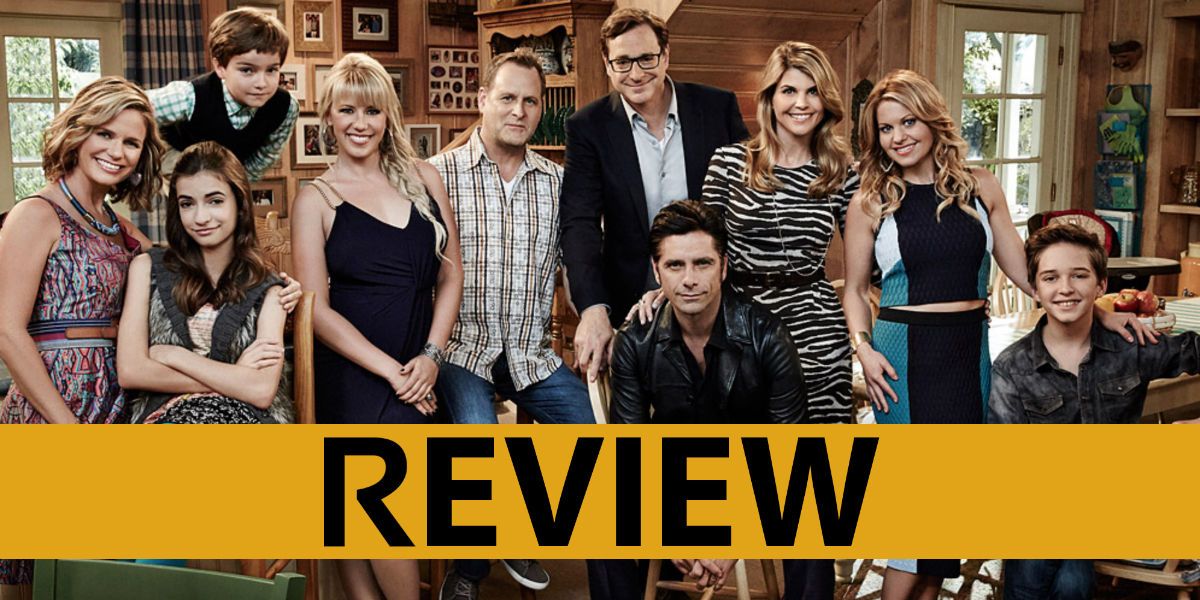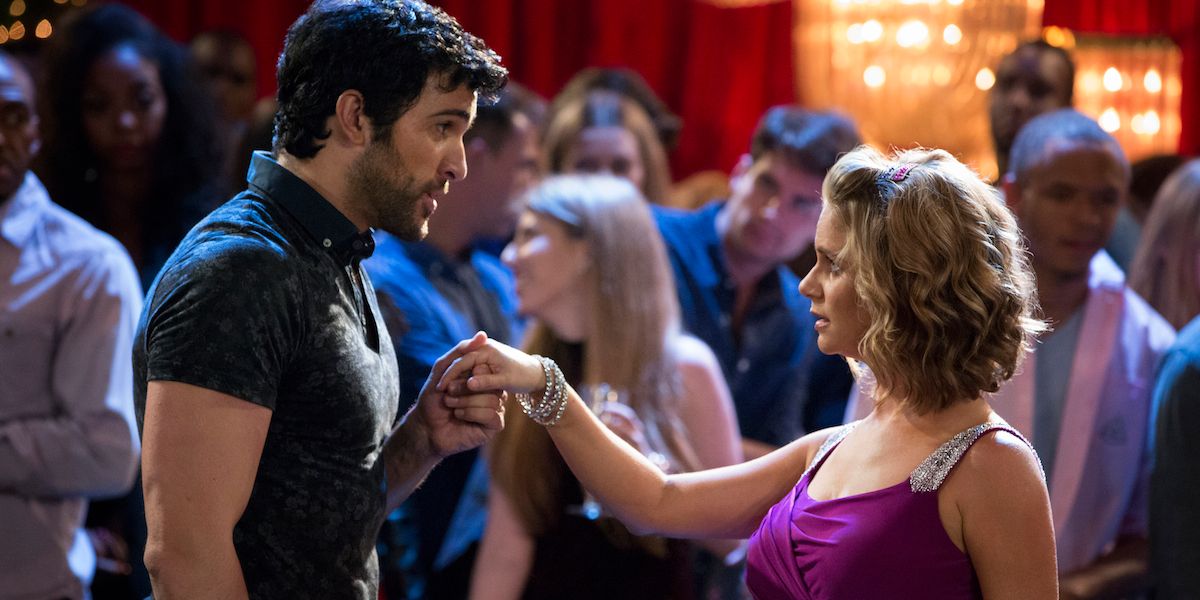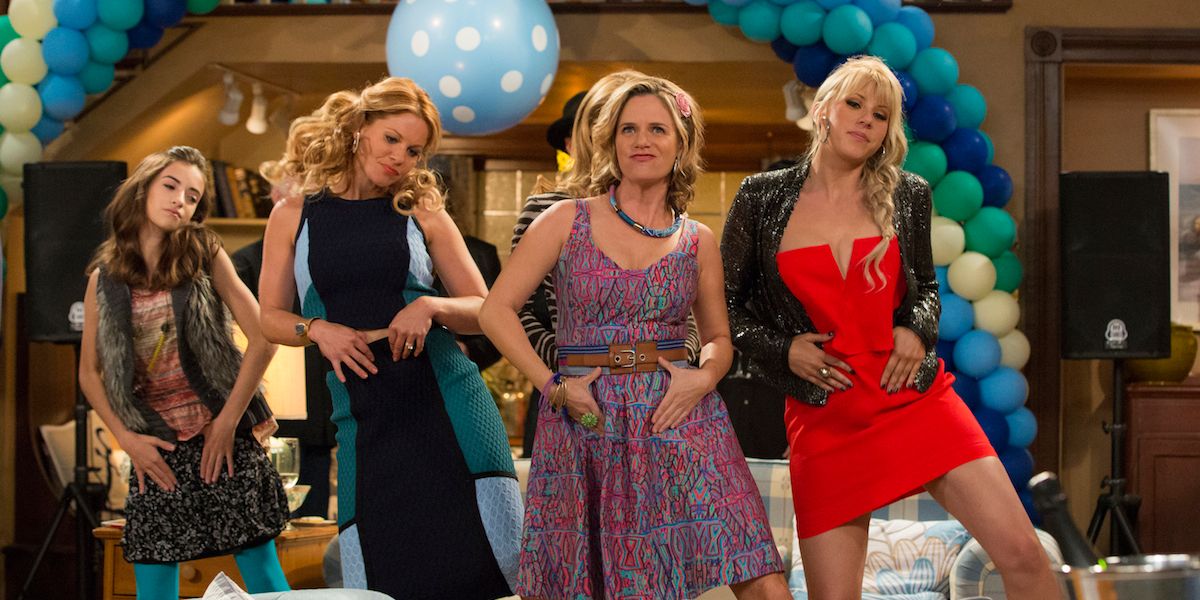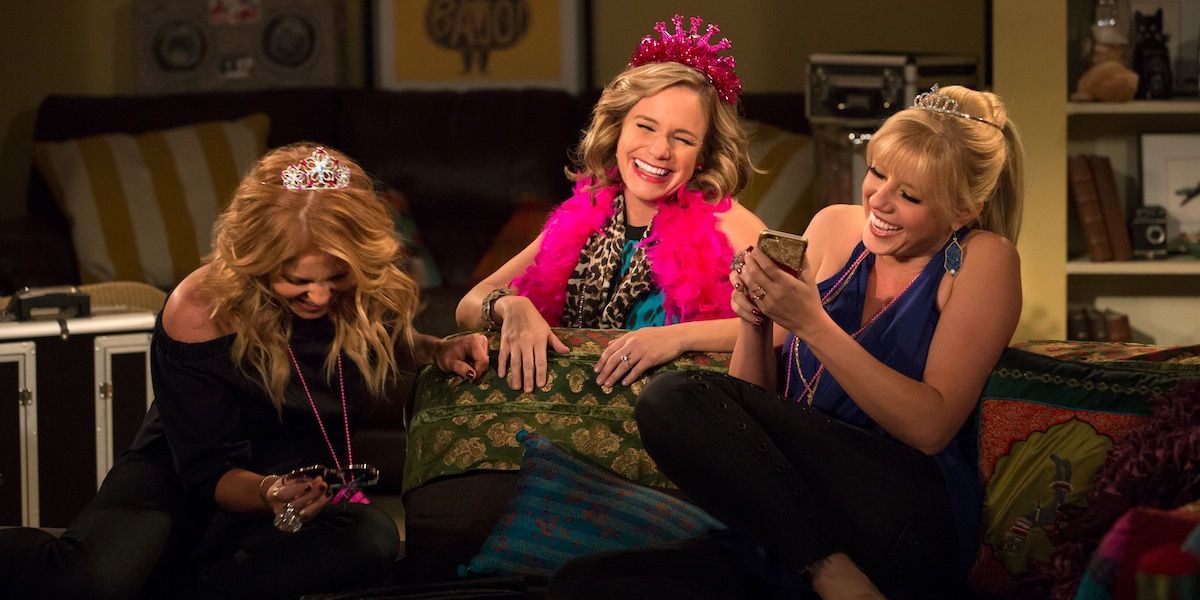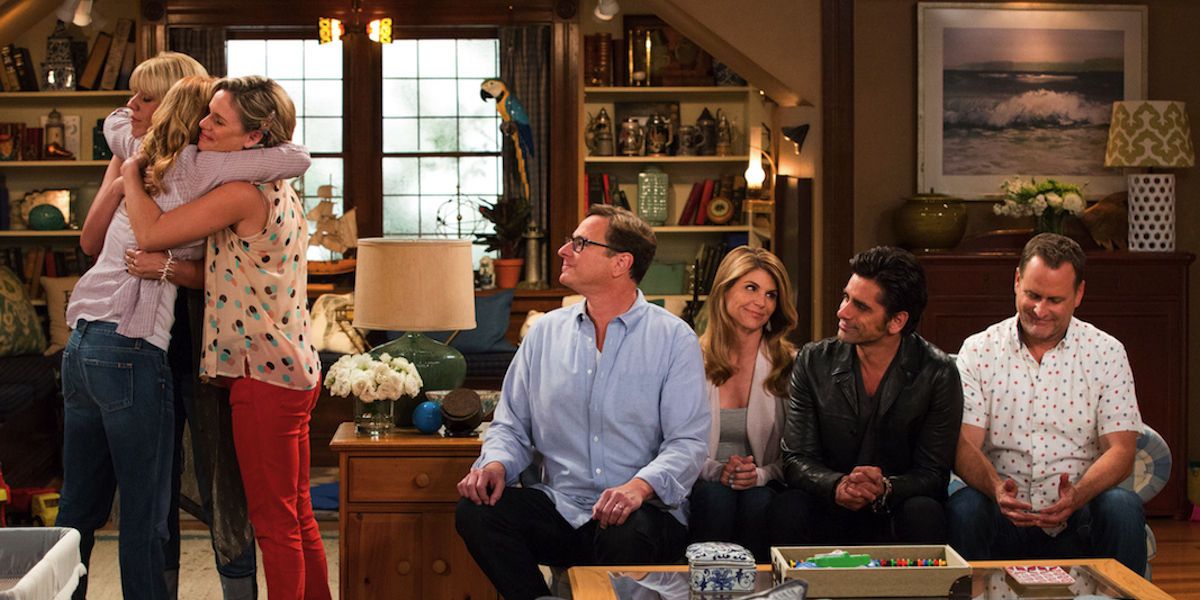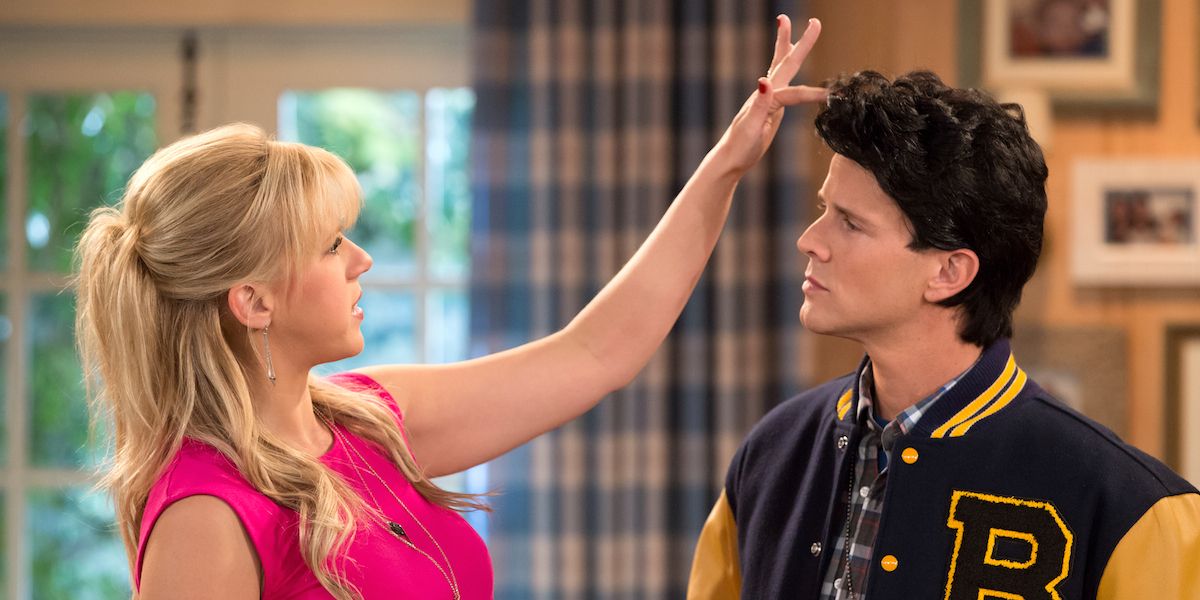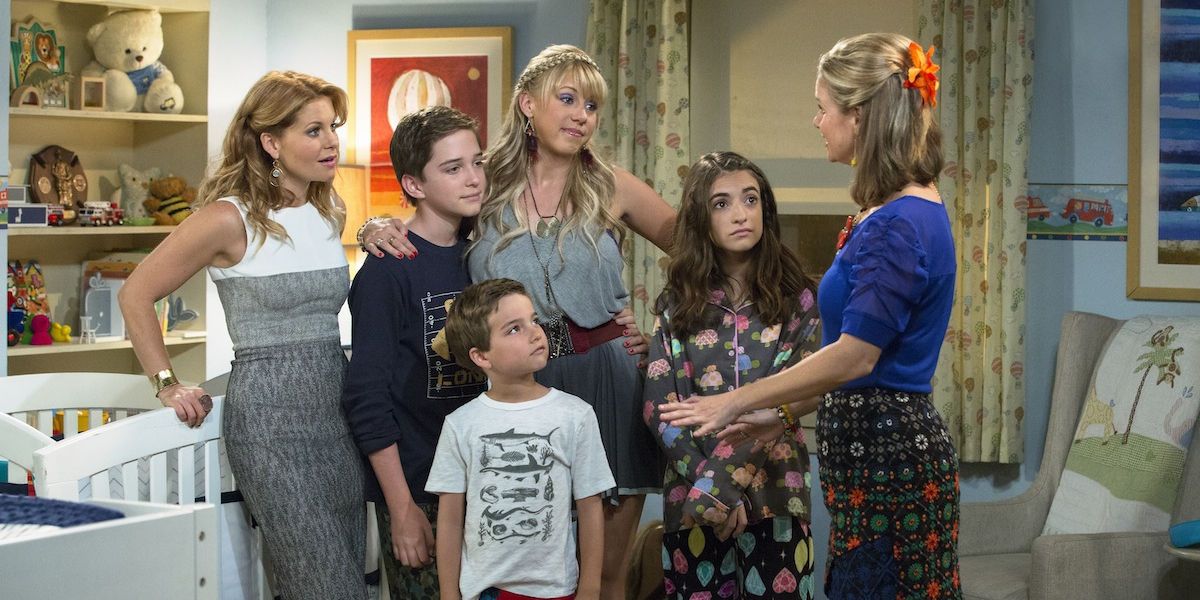[This is a review for season 1 of Fuller House. There will be SPOILERS.]
–
The concept of a Full House revival may have started out as a joke, but Netflix brought the Tanner family back to the forefront of pop culture with the sequel series Fuller House. Most of the cast of Full House signed on to return for the Netflix series, but throughout the show's production rumors circulated about the involvement of Mary-Kate and Ashley Olsen - who shared the role of youngest Tanner daughter Michelle - though it was eventually confirmed they wouldn't appear. Still, the majority of the Tanner-Gibbler-Donaldson-Katsopolis-Gladstone clan returned for the family-oriented Netflix show.
Fuller House revolves around the eldest Tanner daughter, D.J. (Candace Cameron-Bure), a recently widowed veterinarian who is left taking care of her three sons: 13-year-old Jackson (Michael Campion), 7-year-old Max (Elias Harger), and baby Tommy Jr. (Dashiell & Fox Messitt). With her father, aunt, and uncles gone from her childhood home, D.J. is joined by her sister Stephanie (Jodie Sweetin) and her best friend Kimmy (Andrea Barber) who has a daughter of her own, Ramona (Soni Nichole Bringas).
Popping in and out of the Tanner's famous family home during the season - after their official sendoff in the series premiere, 'Our Very First Show, Again' - are Danny Tanner (Bob Saget), Jesse Katsopolis (John Stamos), Rebecca Donaldson-Katsopolis (Lori Loughlin), and Joey Gladstone (Dave Coulier). Additionally in season 1, D.J. attempts to decide whether she's ready to move on from the loss of her husband and begin dating again, with both her high school ex-boyfriend Steve Hale (Scott Weinger) and her co-worker Dr. Matt Harmon (John Brotherton) pursuing her affections. Meanwhile, Kimmy has an on-again, off-again relationship with her husband from whom she's separated, Fernando (Juan Pablo Di Pace), who is also Ramona's father.
In addition to the romantic plots of D.J. and Kimmy, Steph struggles to balance her family life with the career she has built as a DJ - called DJ Tanner to D.J.'s annoyance. As for the kids, Jackson has a tough time coming to terms with living with so many women, especially Ramona, and he later develops a crush on Ramona's friend Lola (Ashley Liao); Ramona wants for her mother and father, and subsequently her family, to be reunited; and Max adopts one of Comet Jr. Jr.'s puppies and names him Cosmo. The show brings all of these threads together in the season finale, 'Love is in the Air', in a way that would have felt like a decent conclusion to the series if it weren't coming back for season 2. Here are the high and low points of Fuller House season 1 - as well as where the show went horribly wrong.
The Good
New Material
The first half of the season feels rather aimless as show attempts to establish how the characters are fitting in with each other in the new mixed family situation created in the first episode of Fuller House. However, it comes off more as the show trying to figure out what to do with its characters. The season begins to lock into place around the time of 'Mad Max' as it gives its characters more serious moments to tackle - such as Stephanie revealing that being an aunt has come to mean so much to her because she isn't able to have children of her own.
The topic is, for the most part, brushed aside after Stephanie's revelation and subsequent emotional conversation with D.J., but it gave the character her first (and possibly last) moment of serious emotional weight. Fuller House rarely broaches serious topics - with the exception of D.J.'s husband and the boys' father's death, which is still only briefly touched upon a handful of times - and when it does, the show stays strictly to a surface level dive into those issues. Still, the effort to attempt a serious character development for Steph through this revelation should be applauded, especially as television rarely delves into the realities that children just aren't a possibility for some women.
Undoubtedly, Fuller House better handles its theme of family throughout season 1, between the mixed family of the Tanner-Fuller-Gibblers now living in the house and Ramona's wish to see her smaller family reunited - even if that means leaving her new home. Although the mixed family unit isn't necessarily a new theme to the Full House franchise, since it was a huge part of the original sitcom, the pull of Ramona and Kimmy between the Fullers and Fernando was entirely original and much more realistic to modern audiences.
Nostalgia
On the whole, the first season of Fuller House doesn't lean into the Full House nostalgia as much as the first episode, which is almost entirely comprised of quotes and references to the original sitcom. Instead, the characters' catch phrases and other nods to Full House are peppered in throughout the other 12 episodes in a manner that is more along the lines of an ostentatious wink than an attention-grabbing shout.
Still, for those fans of Full House - of which there are many - these references in Fuller House are high points of the season. D.J. exclaiming "Oh my lanta!" Steph proclaiming "How rude!" and Kimmy's use of "Tanneritos" are all sure to invoke the power of nostalgia in those watching that grew up with the Tanners in the '80s and '90s. Fuller House leans into its roots in Full House in a way that will surely endear itself to those viewers - and, in fact, likely already has, given the show's season 2 renewal.
The Bad
Nostalgia & Revisiting The Old
For all the ground gained with Full House fans by inserting catch phrases and bringing the older generation back throughout the season, Fuller House's need to recognize the original series is a drag on season 1's momentum. The catchphrases may occasionally feel natural in the mouths of Cameron-Bure, Sweetin, and Barber, but for the most part their delivery is forced and clunky. Furthermore, many of the jokes from Full House simply don't land anymore. For instance, Danny, Becky, Jesse, and Joey continue with their "Kimmy is gross and weird" schtick even though Fuller House works to develop Kimmy into a more well-rounded character. These two conflicting motivations make all of the jokes come off more as tone-deaf than funny nods to Full House.
Furthermore, many other references to the original sitcom come off similarly tone-deaf, perhaps even cruelly so, like the mentions of Michelle's whereabouts and the existence of Mary-Kate and Ashley Olsen as former child stars in the universe of Fuller House. There seemed to be some not-so-goodwill between the cast and the Olsen twins - with Fuller House producers even reaching out to their younger sister Elizabeth Olsen to step into the role of Michelle - prior to the release of the show on Netflix. As a result, the fourth wall-breaking look into the camera in the series premiere and the subsequent comments about the Olsens not needing to act anymore because of their fashion empire come off unnecessarily petty - to the point that some viewers may understand their not wanting to return to the series.
As for the returning cast, it seemed many members of the older generation were phoning it in. While Stamos' excitement to return to the role of the Elvis-loving, musically talented Uncle Jesse was palpable in the ease with which he returned to the part, Saget's reprisal of the sentimental, clean house-loving Danny felt wooden at best. Additionally, Loughlin's return as a baby-crazy Aunt Becky was well-played by the actress with plenty of humor, but again felt incredibly tone-deaf when contrasted with Stephanie's (brief) struggle with not being able to have children. Coulier, for his part, was serviceable in his return to Joey, though he had the least amount of screen time of any of the returning adults.
Incredibly Cheesy
At the end of the day, Fuller House is a sitcom that harkens back to those of the '90s, complete with outlandish episode plots, cheesy resolutions, and a laugh track that may or may not be from a live studio audience (it doesn't matter because either way it's distracting). Season 1 includes painfully cheesy plots including one focused on an American-only Mexican wrestling league and one about Steph being the bad luck charm for the San Francisco Giants' Hunter Pence. Though these episodes, 'The Legends of El Explosivo' and 'A Giant Leap', are somewhat saved by furthering other emotional or story arcs, the situations are so contrived as to be cringe-inducing.
Of course these are moments in which the spirit of Full House shines through, since the original sitcom is known to be as full-on cheesy as Fuller House season 1. But, these storylines - along with a poorly explain Bollywood dance number later in the season - may not land with all viewers because they go too over-the-top. Though the over-the-top cheesy nature may be indicative of its sitcom nature and roots, Fuller House may have been better served by toning it down.
Steve
If Fuller House has an overarching season 1 plot, it's D.J.'s struggle to deal with moving on from her husband and begin dating again - which is very quickly replaced with a love triangle between her, Steve, and Matt. The season thankfully concludes with D.J. refusing to choose either man, instead opting to focus on herself and spend time with her three-woman she-wolf pack. Though the love triangle is certainly overdone in television, this conclusion felt fresh enough and earned by the show's previous development concerning D.J.'s feelings of unease about dating.
However, Fuller House does an incredible disservice to both D.J. and Steve's characters, as well as Weinger's return as D.J.'s formerly charming high school boyfriend, by Steve's stark turn into an overly pushy, insecure, and altogether creepy romantic interest. Where the Steve of Full House was supportive of D.J. and gave his affections withouth an expectation that they would be returned, the Steve of Fuller House lords his previous relationship with D.J. over her head under the guise that they're destined to be together now that they're both single again.
Fuller House attempts to establish a reasoning for D.J. to rekindle her relationship with Steve beyond that they were once in a relationship, but pays no mind to - and refuses to address - the fact that there must have been a reason the two broke up after their prom night and a reason D.J. fell in love with the father of her sons. As a result, their relationship in Fuller House is entirely off-putting and poorly developed, though the show attempts to hide these facts with humor that only adds to the discomfort, such as D.J. and Steve's date with him revisiting the '90s and their original relationship.
While Fuller House season 1 often stumbles to bring its new era in line with Full House in a way that satisfies viewers, Steve's portrayal in the series is such a turnaround to his character as to have a detrimental effect on the franchise as a whole. In fact DJ's struggle to choose between her old love and a new relationship is much the same struggle that the show experiences in trying to decide whether to fully entrench itself in '90s nostalgia or attempt to strike out on its own. As is the case with both D.J.'s romantic life and Fuller House, they're better off attempting originality than falling back into old habits.
Conclusion
Fuller House was created for a very specific audience: fans of Full House. The show is unapologetically rooted in being a continuation of the beloved '80s/'90s sitcom to the point that it celebrates its fans and alienates those that didn't watch the original. Certainly, television hasn't cracked the revival code yet, and Fuller House leans more into providing fanservice than other TV revivals, sequels, or reboots we've seen in recent past. This lip service to Full House fans proves to be both a strength and a weakness, engaging diehard fans while turning off potential new viewers.
Still, when Fuller House establishes its own new material, it proves that the show has the potential to become a sitcom that, if not as beloved as Full House, could honor the original in its continuation. Though there are low points of Fuller House season 1, the show could improve by giving its main characters more development and original material, while further developing the young cast, and perhaps even find a better balance of the old and the new in season 2.
-
Fuller House season 1 is currently available to stream on Netflix in its entirety.

